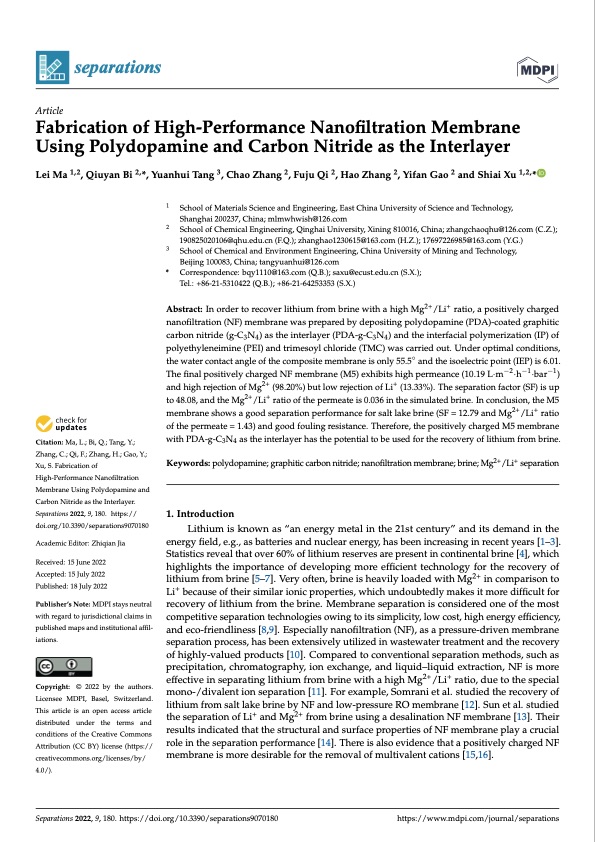
PDF Publication Title:
Text from PDF Page: 001
separations Article Fabrication of High-Performance Nanofiltration Membrane Using Polydopamine and Carbon Nitride as the Interlayer Lei Ma 1,2, Qiuyan Bi 2,*, Yuanhui Tang 3, Chao Zhang 2, Fuju Qi 2, Hao Zhang 2, Yifan Gao 2 and Shiai Xu 1,2,* 1 2 3 * Correspondence: bqy1110@163.com (Q.B.); saxu@ecust.edu.cn (S.X.); Tel.: +86-21-5310422 (Q.B.); +86-21-64253353 (S.X.) Abstract: In order to recover lithium from brine with a high Mg2+/Li+ ratio, a positively charged nanofiltration (NF) membrane was prepared by depositing polydopamine (PDA)-coated graphitic carbon nitride (g-C3N4) as the interlayer (PDA-g-C3N4) and the interfacial polymerization (IP) of polyethyleneimine (PEI) and trimesoyl chloride (TMC) was carried out. Under optimal conditions, the water contact angle of the composite membrane is only 55.5◦ and the isoelectric point (IEP) is 6.01. The final positively charged NF membrane (M5) exhibits high permeance (10.19 L·m−2·h−1·bar−1) and high rejection of Mg2+ (98.20%) but low rejection of Li+ (13.33%). The separation factor (SF) is up to 48.08, and the Mg2+/Li+ ratio of the permeate is 0.036 in the simulated brine. In conclusion, the M5 membrane shows a good separation performance for salt lake brine (SF = 12.79 and Mg2+/Li+ ratio of the permeate = 1.43) and good fouling resistance. Therefore, the positively charged M5 membrane with PDA-g-C3N4 as the interlayer has the potential to be used for the recovery of lithium from brine. Keywords: polydopamine; graphitic carbon nitride; nanofiltration membrane; brine; Mg2+/Li+ separation 1. Introduction Lithium is known as “an energy metal in the 21st century” and its demand in the energy field, e.g., as batteries and nuclear energy, has been increasing in recent years [1–3]. Statistics reveal that over 60% of lithium reserves are present in continental brine [4], which highlights the importance of developing more efficient technology for the recovery of lithium from brine [5–7]. Very often, brine is heavily loaded with Mg2+ in comparison to Li+ because of their similar ionic properties, which undoubtedly makes it more difficult for recovery of lithium from the brine. Membrane separation is considered one of the most competitive separation technologies owing to its simplicity, low cost, high energy efficiency, and eco-friendliness [8,9]. Especially nanofiltration (NF), as a pressure-driven membrane separation process, has been extensively utilized in wastewater treatment and the recovery of highly-valued products [10]. Compared to conventional separation methods, such as precipitation, chromatography, ion exchange, and liquid–liquid extraction, NF is more effective in separating lithium from brine with a high Mg2+/Li+ ratio, due to the special mono-/divalent ion separation [11]. For example, Somrani et al. studied the recovery of lithium from salt lake brine by NF and low-pressure RO membrane [12]. Sun et al. studied the separation of Li+ and Mg2+ from brine using a desalination NF membrane [13]. Their results indicated that the structural and surface properties of NF membrane play a crucial role in the separation performance [14]. There is also evidence that a positively charged NF membrane is more desirable for the removal of multivalent cations [15,16]. School of Materials Science and Engineering, East China University of Science and Technology, Shanghai 200237, China; mlmwhwish@126.com School of Chemical Engineering, Qinghai University, Xining 810016, China; zhangchaoqhu@126.com (C.Z.); 190825020106@qhu.edu.cn (F.Q.); zhanghao1230615@163.com (H.Z.); 17697226985@163.com (Y.G.) School of Chemical and Environment Engineering, China University of Mining and Technology, Beijing 100083, China; tangyuanhui@126.com Citation: Ma, L.; Bi, Q.; Tang, Y.; Zhang, C.; Qi, F.; Zhang, H.; Gao, Y.; Xu, S. Fabrication of High-Performance Nanofiltration Membrane Using Polydopamine and Carbon Nitride as the Interlayer. Separations2022,9,180. https:// doi.org/10.3390/separations9070180 Academic Editor: Zhiqian Jia Received: 15 June 2022 Accepted: 15 July 2022 Published: 18 July 2022 Publisher’s Note: MDPI stays neutral with regard to jurisdictional claims in published maps and institutional affil- iations. Copyright: © 2022 by the authors. Licensee MDPI, Basel, Switzerland. This article is an open access article distributed under the terms and conditions of the Creative Commons Attribution (CC BY) license (https:// creativecommons.org/licenses/by/ 4.0/). Separations 2022, 9, 180. https://doi.org/10.3390/separations9070180 https://www.mdpi.com/journal/separationsPDF Image | Nanofiltration Membrane Using Polydopamine Carbon Nitride

PDF Search Title:
Nanofiltration Membrane Using Polydopamine Carbon NitrideOriginal File Name Searched:
separations-09-00180.pdfDIY PDF Search: Google It | Yahoo | Bing
Product and Development Focus for Infinity Turbine
ORC Waste Heat Turbine and ORC System Build Plans: All turbine plans are $10,000 each. This allows you to build a system and then consider licensing for production after you have completed and tested a unit.Redox Flow Battery Technology: With the advent of the new USA tax credits for producing and selling batteries ($35/kW) we are focussing on a simple flow battery using shipping containers as the modular electrolyte storage units with tax credits up to $140,000 per system. Our main focus is on the salt battery. This battery can be used for both thermal and electrical storage applications. We call it the Cogeneration Battery or Cogen Battery. One project is converting salt (brine) based water conditioners to simultaneously produce power. In addition, there are many opportunities to extract Lithium from brine (salt lakes, groundwater, and producer water).Salt water or brine are huge sources for lithium. Most of the worlds lithium is acquired from a brine source. It's even in seawater in a low concentration. Brine is also a byproduct of huge powerplants, which can now use that as an electrolyte and a huge flow battery (which allows storage at the source).We welcome any business and equipment inquiries, as well as licensing our turbines for manufacturing.| CONTACT TEL: 608-238-6001 Email: greg@infinityturbine.com | RSS | AMP |